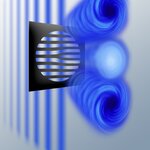Physics

The Large Hadron Collider is increasing gradually the number of proton bunches that circulate in the machine. Yesterday's fill saw 104 colliding proton bunches, producing the record instantaneous luminosity of 3.5 x 10^31 collisions per square centimeter per second. This is no surprise, of course: luminosity is essentially the product of the number of particles crossing each other per second divided by the cross section of the beams, so if you increase the particles and manage to keep the beam transverse size constant, luminosity must go up.
No surprise. Yet it feels good to know that…

"At that time, although recognized for the very high quality and reliability of its accelerator engineering, CERN unfortunately did not have a similar reputation in its physics, and it was still recovering from disasters such as the "split A2" affair. CERN always seemed to be second best behind the leading U.S. laboratories, with their vastly more experienced physicists. And during the 1960s it had been repeatedly beaten into the ground, for example, over the discoveries of the Omega- hypheron, the two types of neutrinos, and CP violation in K0 decay. All these things could and should have…

Scientists know that time passes faster at higher elevations. It's a curious aspect of Einstein's theories of relativity that previously had to be measured by comparing clocks on the Earth's surface and rockets.
But NIST physicists have made it a lot more personal - a scale of about 1 foot - and showed that you even age faster if you are taller than your relative. The good news is you won't be able to see the difference, that one foot difference in height adds about 90 billionths of a second over a 79-year lifetime.
The NIST researchers also observed another aspect of relativity…

Despite time is a scarce resource for me these days, and my "working time balance" shows deep red, I am presently spending some of it to investigate a very interesting statistical effect of general nature, although specially connected to the issue of discovery thresholds in particle physics.
I am triggered by the recent eported observation of a new particle, which has been claimed at a significance corresponding to the coveted 5 standard deviations after a previous evidence had been extracted from 40% less data at 3.8 standard deviations. The matter has left me slightly dubious about the…

I devote only a short piece today to the topic of the week -or the month- in particle physics: as many of you already know, yesterday the CMS collaboration has made public the results of their analysis of two-particle correlations, which evidences an effect never seen before in hadronic collisions, and which has been saluted very emphatically by the press around the world.
The Analysis In Ten LinesIn a nutshell, CMS is observing that in proton-proton collisions yielding a large number of final state particles, there is a long-range correlation between particles emitted at very different…

Black holes draw audiences, because they are weird, they are profound, they are Albert Einstein and Steven Hawking rolled into a singularity. Or some such – except, none of this is actually the case. The black hole is a much more mundane concept, older than relativity, and despite much misinformation in popular and pseudo science, black holes have in a certain sense little to do with relativity (and I say this although and because I worked for many years on black holes and used general relativity when doing so).
Yes, I know, our god Wikipedia claims in the very first sentence that “According…

I am currently running an experiment, with multiple aims. I have created a new blog in wordpress, where I intend to publish a translation to modern Greek of selected articles that I have written in the past. The first attempt is already there (work is in progress, though, given my multiple occupations these days). In the blog I also offer to translate older posts on demand.
The experiment will allow me to improve my mastering of scientific lexicon in Greek. I know it is going to be a bumpy road, but I am determined to pursue it... In the meantime, the blog will allow me to gauge the demand…

"If they would only do as he did and publish posthumously, we should all be saved a lot of trouble".
[Maurice Kendall, famous British statistician, talking of Bayesians (statisticians who employ Bayes' theorem and Bayes' approach to statistical inference, particularly related to the use of "prior beliefs") and of Bayes himself, whose groundbreaking work was only published after his death]

A group of researchers have developed what are known as vortex beams - rotating electron beams - which make it possible to investigate the magnetic properties of materials and in the future it may be possible to manipulate the tiniest components in a targeted manner and set them in rotation also.
Electron beams have been used to analyze materials for a while, such as in electron microscopes. For the most part, the beams' rotation does not affect this analysis because in classical physics, an electron current in a vacuum does not have any orbital angular momentum. But in quantum mechanics, the…

A very important new theoretical study has appeared last Tuesday in the hep-ph preprint arxiv. Titled "Precise Predictions on W+4 Jet Production at the Large Hadron Collider", it is signed by a strong team of theorists: C. Berger, Z. Bern, L. Dixon, F. Febres Cordero, D. Forde, T. Gleisberg, H. Ita, D. Kosower, and D. Maitre.
I believe it may be quite useful if I review here the paper results, and explain to you why they are very important for the physics of the LHC. But first, I feel that there are a few details concerning the process of W+jets production at the LHC which might be obscure to…